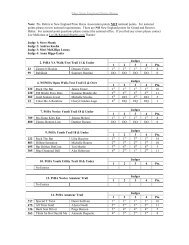2011 Official Rule Book - New England Pinto Horse Association
2011 Official Rule Book - New England Pinto Horse Association
2011 Official Rule Book - New England Pinto Horse Association
You also want an ePaper? Increase the reach of your titles
YUMPU automatically turns print PDFs into web optimized ePapers that Google loves.
ClassEs<br />
2. Each obstacle will be scored on the following basis,<br />
ranging from plus 1 1⁄2 to minus 1 1⁄2: -1 1⁄2 extremely<br />
poor, -1 very poor, - 1⁄2 poor, 0 correct, + 1⁄2 good, +1 very<br />
good, +1 1⁄2 excellent.<br />
3. Obstacle scores are to be determined and assessed<br />
independently of penalty points.<br />
4. Credit will be given to those horses negotiating the<br />
obstacles cleanly, smoothly, and alertly with style in prompt<br />
response to the handler’s cues.<br />
G. Penalties should be assessed per occurrence as follows:<br />
1. One half ( 1⁄2 ) Point<br />
Each tick of log, pole, cone, plant or obstacle.<br />
2. One (1) Point<br />
a. Each hit of or stepping on a log, pole, cone or obstacle.<br />
b. Incorrect or break of gait at walk or jog for two strides<br />
or less.<br />
c. Both front or hind feet in a single-strided slot or space.<br />
d. Skipping over or failing to step into required space.<br />
e. Failure to meet the correct strides on trot over log<br />
obstacles.<br />
3. Three (3) Points<br />
a. Incorrect or break of gait at walk or jog for more than<br />
two (2) strides.<br />
b. Knocking down an elevated pole, cone, barrel, plant<br />
or obstacle, or severely disturbing an obstacle unless<br />
caused by the tail.<br />
c. Stepping outside the confines of, falling or jumping off<br />
or out of an obstacle with one foot once the foot has<br />
entered obstacle; including missing one element of an<br />
obstacle on a line of travel with one foot.<br />
4. Five (5) Points<br />
a. Dropping slicker or object required to be carried on course.<br />
b. First or second cumulative refusal, balk, or evading an<br />
obstacle by shying or backing.<br />
c. Letting go of gate or dropping rope gate.<br />
d. Use of either hand to instill fear or praise (slight<br />
touching or tapping with one hand to cue horse in a<br />
sidepass maneuver only is acceptable).<br />
e. Stepping outside the confines of, falling or jumping off<br />
or out of an obstacle with more than one foot once<br />
the foot has entered obstacle; including missing one<br />
element of an obstacle on a line of travel with more<br />
than one foot.<br />
f. Blatant disobedience (including kicking out, bucking,<br />
rearing, striking or continuously circling the exhibitor).<br />
5. Zero (0) total score for course (disqualification).<br />
a. Performing the obstacles other than in specified order.<br />
b. No attempt to perform an obstacle.<br />
c. Equipment failure that delays completion of pattern.<br />
d. Excessively or repeatedly touching the horse.<br />
e. Failure to enter, exit or work obstacle in any manner<br />
other than how it’s described, including overturns of<br />
more than 1/4 turn.<br />
f. Failure to follow the correct line of travel between<br />
obstacles.<br />
g. Working outside designated boundary marker of the<br />
arena or course area.<br />
h. Third cumulative refusal, balk, or evading an obstacle<br />
by shying or backing over entire course.<br />
i. Failure to demonstrate correct gait between obstacles<br />
as designated.<br />
j. <strong>Horse</strong> gets loose from exhibitor.<br />
k. Leading on the wrong side of the horse<br />
128 <strong>2011</strong> PtHA <strong>Rule</strong> <strong>Book</strong>



